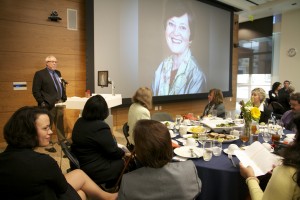ISB Hosts 2nd Annual Valerie Logan Luncheon on Nov. 13
 isbscience.org/news/2013/10/29/isb-hosts-2nd-annual-valerie-logan-luncheon-on-nov-13/
isbscience.org/news/2013/10/29/isb-hosts-2nd-annual-valerie-logan-luncheon-on-nov-13/
Photo above: Valerie Logan during the 2012 Valerie Logan Luncheon.
To inspire students and imbue them with a love for science, technology, engineering and math (STEM), we must inspire their teachers. ISB has always held this philosophy and, at the 2nd Annual Valerie Logan Luncheon on Nov. 13, we will celebrate our vision for bringing quality STEM education to all students and also honor Dr. Meena Selvakumar as the recipient of the 2013 Valerie Logan Leadership in Science Education Award.
The Institute for Systems Biology was founded in 2000 as a visionary biomedical research organization, and supporting STEM education has been an integral piece of ISB’s soul. This is because of Valerie Logan. Valerie and her husband and ISB co-founder, Dr. Leroy Hood, have always advocated for quality STEM education for all students. Valerie’s vision to create long-term partnerships among the scientific community, STEM professionals, and K-12 educators blossomed into the education programs of ISB.

Don McConkey, assistant superintendent of the Snoqualmie Valley School District, spoke a few words after receiving the 2012 Valerie Logan Leadership in Science Education Award.
ISB’s education programs train and support science educators to have the capacity to produce scientifically literate and capable students. We achieve this goal through sustained and long-term collaborations with school districts in which we design customized professional development for elementary, middle and high school teachers. On an annual basis our programs reach 1000 teachers and more than 10,000 students across more than 20 school districts in Washington State.
This year’s Logan Luncheon theme is “Inspiring Teachers to Inspire Students: Partnerships Between Educators and STEM Professionals.” A core component of the event is the presentation the Valerie Logan Leadership in Science Education Award to an individual in the community who embodies Valerie’s vision, commitment and leadership in science education; who has had an impact on ISB’s education programs; and who has inspired others to inspire students. ISB selected Dr. Selvakumar, who is the acting vice president of Strategic Programs at the Pacific Science Center, as the award recipient. Among her many achievements, she developed and directs the Portal to the Public Initiative, which focuses on creating opportunities to expose a general audience of all ages to current scientific research and also to train scientists in how to better communicate their work to a lay audience. Congratulations to Dr. Selvakumar!

Dr. Meena Selvakumar is the 2013 recipient of the Valerie Logan Leadership in Science Education Award.
We invite you to join our community of friends, supporters and partners for the luncheon. We hope you will be inspired to make a contribution of $200, which will directly benefit the education programs at ISB. You will ensure that engaged and enthusiastic teachers continue to open new worlds for all students.
EVENT DETAILS:
Date: Nov. 13, 2013
Time: 12-1:30 p.m.
Place: Institute for Systems Biology, 401 Terry Ave. N., main floor
RSVP: Please register here.






